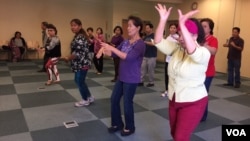Twice a week in Long Beach, California, elderly Cambodian-Americans come together to dance at the local library. But not only is it a way for many in this community to exercise, it also acts as a way to treat stress and depression.
Long Beach is home to the largest enclave of Cambodians in the US. But members of the community of some 60,000 people remain plagued by post-traumatic stress, depression and other mental health issues.
“My husband was always drunk and didn’t even help taking our children to school,” Ly Sokhom, a dance student, told VOA Khmer on a recent morning. “I did sewing and took care of my children’s schooling. Later, I had to stop sewing in order to only take care of my children in school; that’s why I have to come to do this exercise.”
Similarly, Kol Roeup said she has been under constant stress since one of her sons was deported to Cambodia three years ago, while her two other sons graduated from high school but failed to get employment or leave the house.
“They worked for a year or two and then they quit the jobs to stay at home and just play computer games,” she said. “My doctor told me to stop worrying about them and that I need to help myself, without thinking too much. I’m trying this exercise.”
Here, present-day stresses mix with trauma from the past. On Tuesday and Thursday mornings, students learn Western dances, along with traditional styles from Cambodia.
Ann Thoun, who coordinates the program, said dancing can help. “After they endured difficulties during the Khmer Rouge time, they have suffered a lot of mental problems,” she said. The program has been open for almost two years, offering lessons to more than 100 participants along the way. Ann Thoun said she has kept the program going through her own work and donations. “We do not have any financial support at all.”
For students, though, it’s a place to feel some relief from the trauma of the past. “I have mental impacts, because I lost two children, a brother and his whole family, and my uncle and his whole family,” said Sem Sam, another student here. “So this has psychologically impacted me for a long time.”
David Ung, a dance instructor, said the dancing can help get rid of stress and depression, whether they come from the past or the present. “We should do this activity for an hour or two a day, especially old-aged people.”
Taing Sroy, who has been exercising for more than six months, after retiring from his job, said it has helped. “In fact, my health in the past was very bad,” he said. “I had stomach pain and rheumatism. But since taking this class, it helped me.”







